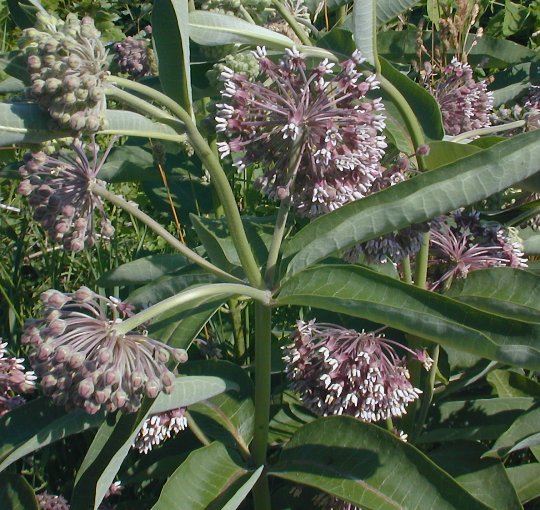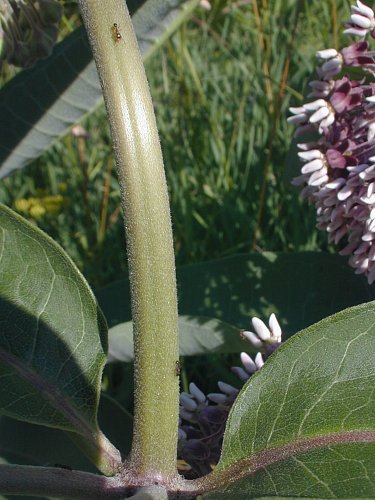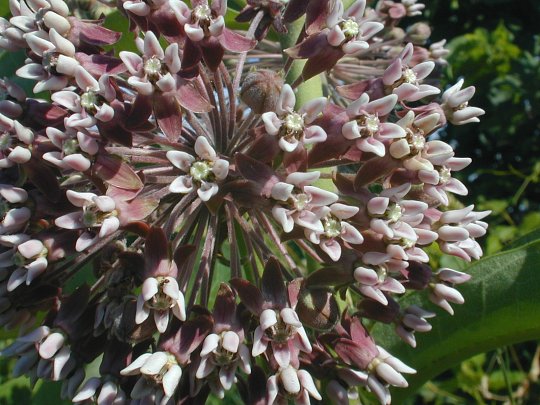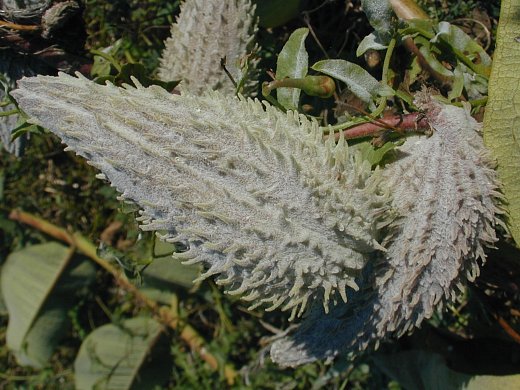Description: This herbaceous perennial plant is 2-6' tall and unbranched, except sometimes toward the apex, where the flowers occur. The central stem is relative stout, pale green, terete, and usually short-pubescent (less often glabrous). The opposite leaves are up to 8" long and 3½" wide, broadly oblong in shape, and smooth along their margins. The upper leaf surface is pale-medium to dark green and hairless above, while the lower leaf surface is densely covered with woolly hairs that are very short. There is a prominent central vein along the length of each leaf, and finer side veins that radiate outward toward the smooth margins. When either the central stem or leaves are torn, a milky sap oozes out that has variable toxicity in the form of cardiac glycosides.

Umbels of flowers, each about 2½-4" across, emerge from the axils of the upper leaves. These flowers are quite fragrant, with a scent resembling violets or pansies, and they range in color from faded light pink to reddish purple. Each flower is about ¼" across, consisting of 5 reflexed petals and 5 raised hoods with curved horns. The hoods are more light-colored than the petals. The pedicels of the flowers are light green to pale red and hairy. The blooming period lasts about 1-1½ months from early to mid-summer. The seedpods (follicles) are 3-4" long, broadly lanceoloid, and covered with soft prickles and short woolly hairs. At maturity, each seedpod split along one side to release numerous seeds that have large tufts of white hair. Dispersion of seed is by wind. The root system has long creeping rhizomes, promoting the vegetative spread of this plant.

Cultivation:
The
preference is full sun, rich loamy soil, and mesic conditions, but this
robust plant can tolerate a variety of situations, including partial
sun and a high clay or sand content in the soil. Under ideal
conditions, Common Milkweed can become 6' tall and spread aggressively,
but it is more typically about 3-4' tall. This plant is very
easy to grow once it becomes established.
Range & Habitat:
The native Common Milkweed occurs in every county of Illinois and it is
quite
common (see Distribution
Map). Habitats include moist to dry black soil prairies, sand
prairies, sand dunes along lake shores, thickets, woodland borders,
fields and pastures, abandoned fields, vacant lots, fence rows, and
areas along railroads and roadsides. This plant is a colonizer of
disturbed areas in both natural and developed habitats.

Faunal Associations: The flowers are very popular with many kinds of insects, especially long-tongued bees, wasps, flies, skippers, and butterflies, which seek nectar. Other insect visitors include short-tongued bees, various milkweed plant bugs, and moths, including Sphinx moths. Among these, the larger butterflies, predatory wasps, and long-tongued bees are more likely to remove the pollinia from the flowers. Some of the smaller insects can have their legs entrapped by the flowers and die. Common Milkweed doesn't produce fertile seeds without cross-pollination. The caterpillars of Danaus plexippes (Monarch Butterfly) feed on the foliage, as do the caterpillars of a few moths, including Enchaetes egle (Milkweed Tiger Moth), Cycnia inopinatus (Unexpected Cycnia), and Cycnia tenera (Delicate Cycnia). Less common insects feeding on this plant include Neacoryphus bicrucis (Seed Bug sp.) and Gymnetron tetrum (Weevil sp.); see Insect Table for other insect feeders). Many of these insects are brightly colored – a warning to potential predators of the toxicity that they acquired from feeding on milkweed. Mammalian herbivores don't eat this plant because of the bitterness of the leaves and their toxic properties.

Photographic
Location:
The photographs were taken at Meadowbrook Park in Urbana,
Illinois, and along a roadside ditch in Champaign, Illinois.
Comments:
Depending on the local ecotype, Common Milkweed is highly variable in
appearance. The color of the flowers may be highly attractive, or faded
and dingy-looking. This plant is often regarded as a weed to be
destroyed, but its flowers and foliage provide food for many kinds of
insects. Common Milkweed can be distinguished from other milkweeds by
its prickly follicles (seedpods) – other Asclepias spp.
within Illinois have follicles that are smooth, or nearly so.